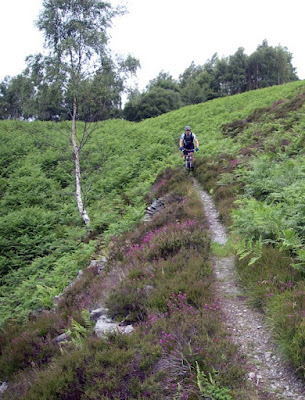Imagine you are at the edge of the sea on a day when it is difficult to say where the land ends and the sea begins and where the sea ends and the sky begins. Sea kayaking lets you explore these and your own boundaries and broadens your horizons. Sea kayaking is the new mountaineering.
Friday, July 20, 2007
On location
Posts will resume soon On west coast Mull no mobile recep Great new photos also assesed new seakayaking pubs Truly seakayak heaven :o)
Monday, July 09, 2007
Sunday, July 08, 2007
Ixodes ricinus and Lyme disease

This charming looking insect is Ixodes ricinus or the hard bodied tick. (The penny is 15mm in diameter.)
It preys on mammals by sucking their blood and storing it in its abdomen. It particularly likes rabbits, sheep, deer and sea kayakers. This year seems a bad season for them and it is worth examining yourself after walking through vegetation like bracken. They climb it in wait and anticipation of feasting upon their next victim.

Traditionally people have pulled then out with their nails or tweezers, burned them off with a cigarette or attempted to suffocate or stun them using Vaseline or alcohol. Unfortunately all these methods cause the little creature to dig further in and to puke its stomach contents into the victim's blood stream. This partially digested blood is a heady cocktail that contains another of God's creations, a spirochete bacterium called Borrelia burgdorferi sensu lato. This causes a condition called Lyme disease in humans. Believe me (and I am a doctor), Lyme disease is something you would much prefer not to have.
Public service announcement: if you get a red ring spreading out from a tick bite you should seek medical advice, mention you have been bitten by a tick and you are concerned about Lyme disease.
A much safer way to remove the injurious, illegitimate and far from insignificant insects is to use a little rotating hook such as the O'Tom, available from all good veterinary surgeries. You slide the tapered fork behind its bloated abdomen then slowly twist without pulling. The tick can resist a pull by digging in with its jaws and fore feet but it's helpless against gentle rotation. Some favour anticlockwise and others clockwise rotation. My own experience is that both are equally effective.
Are you curious what to do with the now pitifully struggling insect which you have untimely ripped from its natural element? Well, this might not be good for your Karma, but the following is my humble suggestion. I take some delight in burning the hapless former parasite.
If only it was so easy to get revenge on the Scottish midge.
Saturday, July 07, 2007
Ayrshire agate

This banded agate was found on the south Ayrshire coast under the cliffs on which Culzean Castle stands. Agates form as nodules within cooling lava. As the lava weathers the nodules are released and get broken open by wave action. They are also found on Ayrshire's raised beaches which are used to grow Ayrshire potatoes. Hunters of the semi precious stones will often follow the tractors which plough the fields.
Friday, July 06, 2007
Treshnish friends.

Sammy, I am not speaking till you get the name right. It's NEVILLE!
Razorbill and Puffin on the Treshnish Isles.
Tuesday, July 03, 2007
Tiderace Seakayaks.

Tiderace Seakayaks is a new name on the UK sea kayaking scene. Aled Williams (formerly of Rockpool kayaks and designer of the delectable Alaw and Alaw Bach) has decided to rename his new company (formerly known as In-Uit Kayaks) in respect of the tradition and culture of the Inuit people who come from the Arctic territories of Alaska, Canada and Greenland. Michael, who has spent a great deal of time with these people, has already drawn attention to the appropriateness of the name. I am sure Aled chose the name out of respect to the Inuit origins of our sport. I am equally sure that Aled has made the correct and sensitive decision to rename the company.
I like the name Tiderace and here is Kenny paddling an Aled designed boat in a tide race: the Cuan Sound.





